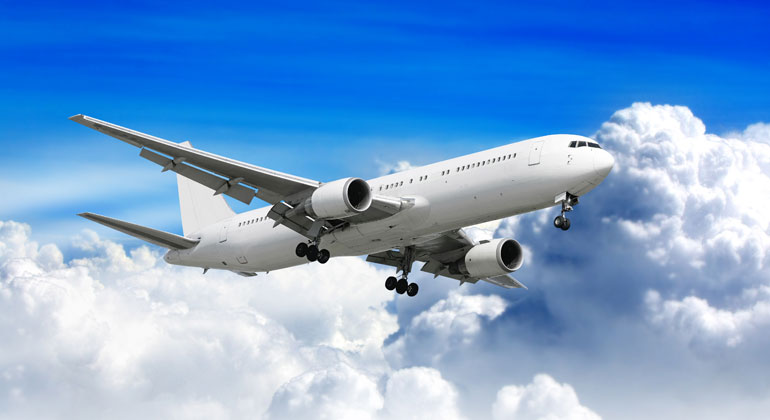Global air transport contributes 3.5 percent to global warming
Global air transport accounts for 3.5 percent of anthropogenic climate warming.
It is also apparent that only one third of aviation’s climate impact is due to carbon dioxide emissions and two thirds to non-carbon-dioxide effects, with contrails and the resulting cirrus clouds being the most significant factor. These are the findings of a comprehensive international study led by Manchester Metropolitan University and involving the German Aerospace Center (Deutsches Zentrum für Luft- und Raumfahrt; DLR), which was published in the journal Atmospheric Environment on 3 September 2020.
The study is the first of its kind since 2009 and provides the most comprehensive insight to date into the impact of air transport on the climate with calculations based on a new metric. Researchers are analysing all the factors that the air transport industry has contributed to climate change since its inception, including emissions of carbon dioxide, nitrogen oxides, and the effect of condensation trails and contrail cirrus clouds (clouds of ice crystals produced by aircraft engines at high altitude under certain meteorological conditions). The study also includes other climate-relevant emissions such as water vapour, soot, aerosols and sulphate aerosol particles found in the exhaust plumes of aircraft engines.
Focusing on Earth’s radiation budget
With the first use of the updated metric introduced by the Intergovernmental Panel on Climate Change (IPCC) in 2013, the current study opens a new chapter in the analysis of the climate impact of air transport. The new metric is known as Effective Radiative Forcing (ERF) and represents the increase or decrease in the balance between the energy arriving at Earth from the Sun and the energy emitted by Earth since pre-industrial times. ERF makes the radiation budget of Earth’s atmosphere the focal point of the analysis. This is the first time that the effects of spatially inhomogeneous phenomena, such as how the occurrence and effects of contrails varies globally depending on air traffic and weather conditions, have been taken into account in calculations.
“Using the new ERF metric, we found that contrails have less than half of the previously estimated climate impact, but still make air transport’s largest contribution to global warming,” explains Robert Sausen from the DLR Institute of Atmospheric Physics in Oberpfaffenhofen. “Contrails reflect solar radiation into space, which has a cooling effect. However, they also reduce Earth’s own heat radiation, which warms the climate. On average across the globe, the warming effect dominates. Carbon dioxide emissions are the second largest contribution to the climate impact of air transport. In contrast to the effects of contrails, which have a comparatively short life span of a few hours, the effect of carbon dioxide on the climate lasts for many centuries, during which the gas is to a large extent evenly distributed over the long term.
32.6 billion tonnes of carbon dioxide
The study concludes that 32.6 billion tonnes of carbon dioxide have been emitted by global air transport throughout the industry’s entire history – considered between 1940 and 2018. Approximately half of the total cumulative carbon dioxide emissions were generated in the last 20 years alone, primarily due to increasing numbers of flights and routes, and expanding fleet sizes, particularly in Asia. The research team estimates that the figure of 32.6 billion tonnes represents around 1.5 percent of total anthropogenic carbon dioxide emissions. If the non-carbon-dioxide effects are included, the share of air transport in all human activities that drive global warming is calculated at 3.5 percent.
The scientists carried out a comprehensive analysis of the individual factors influencing the climate impact of air transport in order to calculate its overall climate impact for the first time. Similar, less detailed studies were conducted in 1999, 2005 and 2009. In future, it will be possible to compare the climate change impact of air transport with other sectors such as maritime traffic, ground transport, and energy production on the basis of these results.
Technologies to limit climate impact
For the air transport system of the future, DLR is already researching methods and technologies to achieve carbon-dioxide-neutral aircraft which will make use of biofuels, hydrogen and hybrid electric propulsion systems. “The use of biofuels also leads to lower soot emissions and thus reduces the effects of cirrus clouds as a driver of climate change,” explains Ulrike Burkhardt from the DLR Institute of Atmospheric Physics in Oberpfaffenhofen. In order to reduce the non-carbon-dioxide effects, DLR is also investigating procedures for optimising flight routes and altitudes to help minimise climate impact. Using alternative flight routes, for example, allows aircraft to avoid regions and flight altitudes where the temperature and humidity would likely give rise to contrail formation.
Institutions participating in the study under the leadership of Manchester Metropolitan University MMU (GB): National Oceanic and Atmospheric Administration NOAA (USA); University of Oxford (GB); DLR (DE); Peking University (China); University of Colorado (USA); University of Leeds (GB); Center for International Climate Research CICERO (Norway); National Center for Atmospheric Research NCAR (USA); University of California, Irvine (USA); University of Michigan (USA); University of l’Aquila (I); University of Reading (GB).








